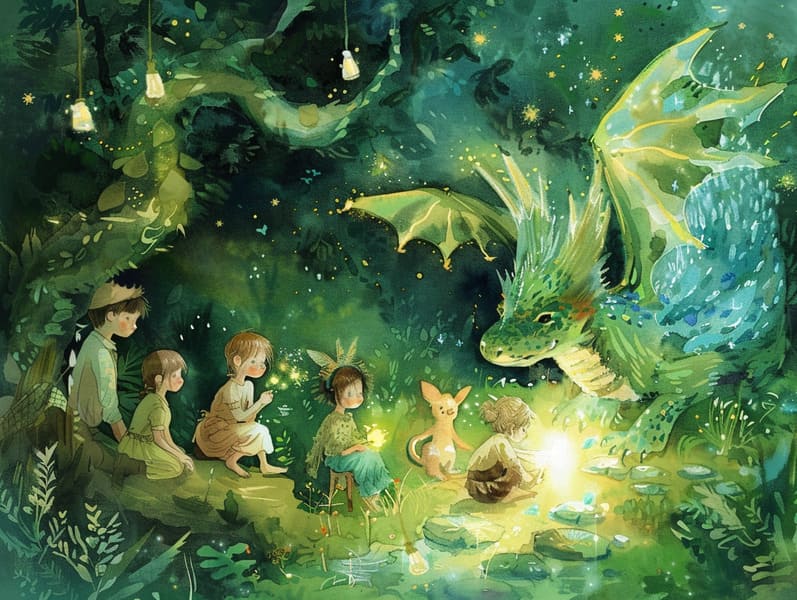The Formation of Fairy Tales for Kids with the Unfading Delight.
The Formation of Fairy Tales for Kids with the Unfading Delight.
Blog Article

Popular fairy tales have old origins. These stories have been whispered from one generation to the next centuries before they were ever documented. They developed from a variety of cultures, including Indigenous traditions. They were initially conveyed among mature audiences, often carrying themes and messages relevant to the societal norms and beliefs of the time.
The Grimm brothers, the two Grimm brothers, were among the first to collect many of these beloved fairy tales. Their compilation, "Grimm's Fables," included classics like "Cinder Maid," "Little Brother and Little Sister," and "Schneewittchen," which have since become hallmarks in the world of traditional fairy tales. Similarly, the Danish author's magical tales, such as "The Mermaid," and "The Little Duckling," have enchanted hearts worldwide, guaranteeing their place in the pantheon of classic fairy tales.
Though they are old, fairy tales remain as relevant as ever, especially as kids' bedtime tales. These fantastical tales are now available in various formats, including gorgeously illustrated books, delightful animations, and online storybooks.
Their unwavering allure can be connected to several fascinating points:
Vital Lessons: Traditional fairy tales often share important moral lessons. Narratives like "The Shepherd Boy and the Wolf" teach the value of being truthful, while "The Race of the Tortoise and the Hare" demonstrate the values of persistence and modesty. These tales offer kids clear distinctions between virtue and vice, building their moral compass in a kind yet impactful way.
Warmth and Understanding: Fairy tales frequently illustrate characters facing trials and tribulations, motivating readers to resonate with their struggles and cheer for their triumphs. For instance, "Beauty's Beast" reveals the importance of seeing beyond the surface to know the true essence of a character, nurturing empathy and awareness.
Cultural Insights: Many fairy tales are infused with the cultural contexts from which they developed. Engaging with these fairy tales can provide illuminating insights into different traditions, fostering a sense of world appreciation and recognition.
Imagination and Creativity: The extraordinary elements in ancient fairy tales—wizardry and magic—fire up children’s creativity. These stories take readers to magical realms, triggering imaginative dreams and a sense of wonder that remains a lifetime.
Ancient fairy tales are not only charming but also instructive. They work as fantastical tools in promoting various thinking and feeling skills in children. When fairy tales are recited, they cultivate linguistic abilities by presenting new terms and intricate sentence structures. This practice also advances hearing abilities and focus, as the young hang on every word, anxious to see what happens next.
Furthermore, examining the themes and characters of timeless fairy tales can foster critical thinking and cognitive skills. Little ones are led to see patterns, expect results, and make sense of cause and effect. These reflections also support children voice their thoughts and feelings, fostering their emotional intelligence.
In today’s digital age, the existence of digital storybooks has made these narratives more accessible than ever. Web-based platforms and applications give comprehensive collections of famous fairy tales that can be looked at or played anytime, anywhere. Fairy tales spoken are particularly prevalent, sharing an charming way for young ones to take part in these entrancing tales. Voice books and voiced videos take characters and settings to life, often paired with enchanting music and music that augment the tale experience.
The lasting allure of classic fairy tales lies in their ability to shift to the present while retaining their central values. Contemporary renditions of these stories often include more representative protagonists and modern settings, making them relatable to today’s audience. However, the main ideas of boldness, kindness, and justice remain unchanged, continuing to affect kids of all ages.
Old fairy tales also offer a sense of ease and homeliness. They extend a orderly narrative with a clear beginning, middle, and end, often finishing with the closure of conflicts and the triumph of justice over injustice. This predictability can be calming for little ones, imparting a sense of reliability in an shifting world.
Old fairy tales continue to charm and instruct new generations, maintaining their enchantment and applicability in modern society. As nighttime stories for kids, they confer upon a perfect blend of delight and instruction, sustaining moral values, empathy, and creativity. The availability of digital storybooks and the likability of fairy tales recited promise that these ancient stories remain within reach to new generations.
By preserving and releasing these fairy tales, we continue to appreciate the rich tapestry of website tradition and cultural heritage. Whether you are seeing a richly illustrated book, seeing a internet library, or hearing an narrated book, the beauty of Grimm's fairy tales is always within reach. These fairy tales convey of the immortal essence of fairy tales and its ability to bind us across eras and regions.
Regardless if you are exploring a gorgeously illustrated book, accessing a web-based library, or hearing an audio story, the enchantment of bedtime fairy tales is always within reach.
These narratives highlight of the unending ability of narratives and its ability to unite us across eras and regions, establishing a link that enchants and educates alike.